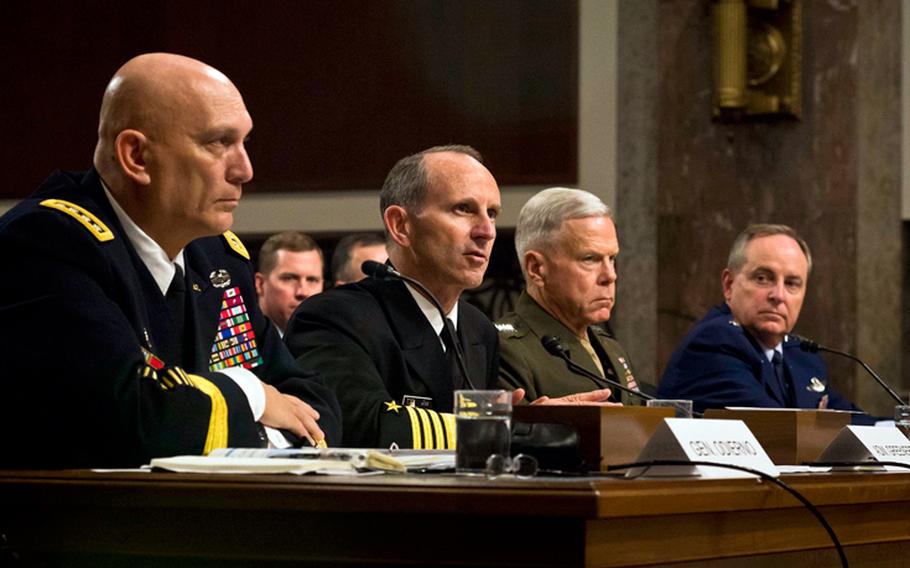
From left, Army Chief of Staff Gen. Raymond Odierno, Chief of Naval Operations Adm. Jonathan Greenert, Marine Corps Commandant Gen. James Amos and Air Force Chief of Staff Gen. Mark Welsh testify on Capitol Hill in Washington, on Thursday, Nov. 7, 2013, before the Senate Armed Services Committee on budget cuts to the military. (Peter D. Lawlor/U.S. Navy)
The Military Times reports that while military and civilian personnel costs have grown by 78 percent between 2001 and 2012, the overall defense budget has been growing even faster, calling into question the emphatic calls from Pentagon brass to reduce personnel-related costs.
That’s less than the increases in total military spending, which is up 85 percent since 2001, and more than 104 percent when funding for overseas contingency operations are factored in. From that perspective, The Military Times noted, personnel costs are actually shrinking as a share of the entire defense budget.
Personnel costs have grown — but so has the cost of everything else, including costs related to operations, maintenance and new weapon systems.
Citing documents available via the Defense Department and White House websites, The Times reports:
The portion of the defense budget titled “Military Personnel” was 24.16 percent of the Pentagon budget in 2012, showing essentially no increase over 2001, when it was 24.13 percent. The “Military Personnel” share of the budget today is far below its recent historic high of 30.5 percent in 1991, the Operation Desert Storm era. Health care costs are often lumped into “personnel costs,” although a significant portion of those expenses are logged outside the personnel budget accounts. Among the three service branches, the Army is the only one to show an increase in the proportional size of its Military Personnel budget account, which rose from 38 percent of the Army budget in 2001 to 45 percent in 2012, due largely to the fact that the Army ballooned over that time from about 480,000 active-duty soldiers to about 555,000 — a trend that is swinging hard the other way. Experts quoted by The Military Times say some statements from the top brass are flat-out overblown.
Gordon Adams, a former national security budget director for the White House, suggested that focusing attention on military personnel costs is being done in an effort to shape the political debate in Washington.
Congress is deeply resistant to cutting pay and benefits. So the Pentagon leadership’s rhetorical focus on soaring personnel costs may help reduce pressure on the broader military budget.
“If you focus on the least doable thing, what you gain is leverage to bring the whole budget up,” Adams said. “By pointing to the hardest thing to change, they hope that the whole budget will continue to be high.”
Other experts, according to the report, say it’s more about the top brass aiming to protect other parts of the budget, such as tanks, ships, planes, vehicles and other weapons.
For the moment, however, it seems likely that personnel costs — and the laws and policies that drive them — will remain in the cross hairs.
Pentagon leaders have hinted that the next DoD budget request for fiscal 2015, due out in February, will include a slew of budget-cutting proposals. Preliminary reports suggest they may include:
Shaving money from the Basic Allowance for Housing budget by returning to a policy of making troops pay a portion of their off-base housing costs out of pocket. Limiting access to Tricare health coverage for working-age retirees under 65 by requiring them to use their current employer health plans if available. Capping servicemembers’ future pay raises at a level slightly below private-sector wage growth. Underpinning Pentagon discussions are remarkably strong recruitment and retention numbers in recent years, which some say show that the Pentagon may be paying too much compensation to attract and retain the manpower it needs, the Times noted.
Before 9/11, military pay was somewhere between the 60th and 70th percentiles of pay for civilian peers. But a Pentagon study last year concluded that enlisted members now are paid better than 90 percent of peers with similar age and education levels, while officers are paid better than 83 percent of civilians with bachelor’s degrees.
“That’s a lot,” Cindy Williams, a former Pentagon budget official who teaches at the Massachusetts Institute of Technology, told the Times.
“At some point, you have to ask, what’s the amount that is ‘enough’? I think most personnel experts agree that the amount should be a fair recognition of the sacrifices of military life, but also should be targeted to bring in the people you want and keep them motivated to do a good job.”